Static testing is an essential technique in software quality assurance that helps identify flaws early in the development lifecycle. Unlike dynamic testing, which requires executing the application, static testing involves analyzing code, documentation, and other project artifacts without running the software.
By enabling early detection of issues, static testing enhances software quality, reduces development time, and contributes to long-term project stability. It also promotes better collaboration among teams and minimizes rework.
As a core part of the software verification process, static testing offers value across various stages of development. A well-defined static testing process allows QA teams to ensure software integrity before any code is executed.
Important Features of Static Testing:
- Early Detection: Assists in finding errors before the code is executed.
- Cost-effective: Reduces late-stage defect repair costs
- Non-execution Based: entails examining documentation, code, and designs.
- Quality-Focused Methods: Utilizes structured techniques to ensure comprehensive software validation
💡 What’s next? Keep reading to discover:
📌 Why Static Testing Is a QA Essential?
📌 Must-Know Static Testing Techniques.
📌 Static vs. Dynamic Testing Explained.
📌 Discover how requirement and documentation checks reduce rework and misalignment.
📌 Get familiar with leading static testing tools and solutions to adoption hurdles.
Top Static Testing Techniques Used by QA Professionals
Static tests employ a range of methods to ensure end-to-end software quality. These techniques focus on analyzing the source code, design specifications, and software requirements to catch programming errors, syntax issues, and compliance with coding standards before they escalate into major defects.
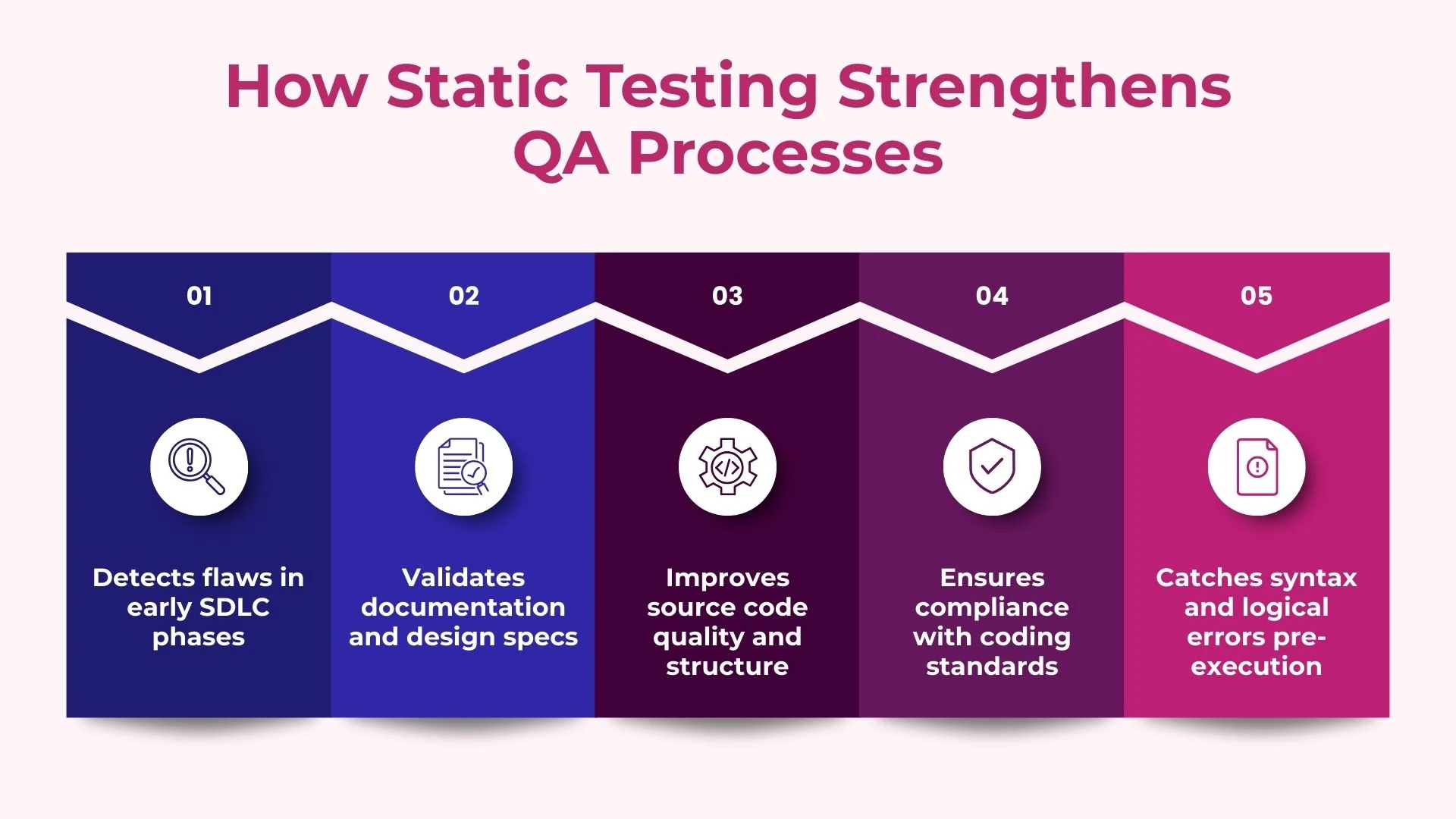
The following are key static testing techniques used across the software application lifecycle:
- Code reviews: Conducted by peers or experts to inspect structure, logic, and adherence to standards.
- Walkthroughs: Informal sessions where the author explains the code, while reviewers ask clarifying questions.
- Inspections: Formal review sessions that follow a structured approach, including assigned roles, specific entry and exit conditions, and comprehensive checklists to ensure thorough evaluation.
- Static analysis: Static analysis detects code issues early using automated tools.
- Review analysis: Involves thorough examination of comprehensive documentation, such as user guides, test cases, and architecture diagrams.
In addition, incorporating product review analysis evaluating user feedback after release can offer actionable insights to refine future development approaches, enforce coding best practices, and improve documentation.
Altogether, static testing provides numerous benefits, including early fault detection, improved maintainability, and higher software quality, making it a cornerstone of efficient static application and static code testing processes.
Static Testing vs Dynamic Testing
Implementing a comprehensive software testing strategy requires an understanding of the distinctions between static testing and dynamic testing. While the static testing process is performed early in the development phase—often across multiple stages of development—it relies on various static testing methods like code reviews, walkthroughs, and the use of static code analyzers.
While dynamic testing techniques verifies behavior during runtime, static testing focuses on actual code, documentation, and design artifacts before runtime, improving development productivity and reducing testing costs in the long run.
When combined, the complementary nature of static and dynamic testing ensures that software is validated both pre- and post-execution, enhancing quality across all phases of the software development life cycle.

Static and dynamic testing differences:
Static Testing:
Without running the programming code, static testing is carried out. Early in the software development lifecycle, it uses methods including code reviews, walkthroughs, and static analysis to find problems with syntax, logic, and documentation.
- Finishing without running the code
- Includes static analysis, software code review, and walkthroughs.
- Initial stages of activity
- Looked for problems in the documentation, logic, and syntax.
Dynamic Testing:
Dynamic testing refers to the execution of a software application to assess its performance and functionality based on established technical specifications and business needs in simulated real-world environments.It plays a vital role in uncovering critical issues, potential vulnerabilities, and performance bottlenecks that can only be observed at runtime.
Key characteristics of dynamic testing methods include:
- Requires the actual software application to be run to evaluate its output and behavior.
- Encompasses both functional (e.g., UI and integration testing) and non-functional tests (e.g., performance testing).
- Typically carried out during or after the coding phase of development.
- Effective in identifying runtime errors, unstable logic, and deviations from expected performance benchmarks.
By simulating user interactions and various operational conditions, dynamic testing provides insights into system responsiveness, security posture, and real-time functionality—ensuring the final product aligns with user expectations and technical specifications.
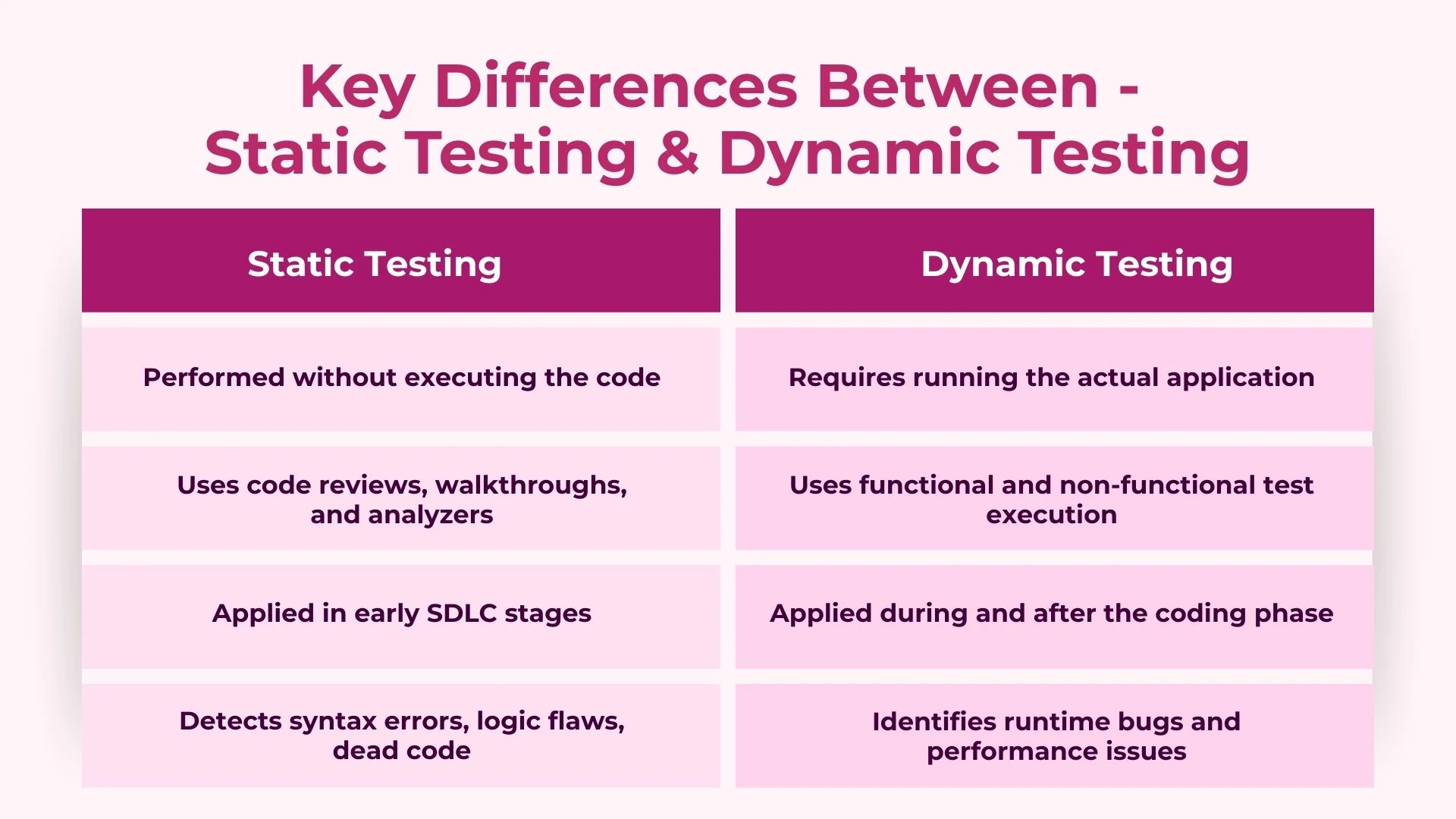
Formal Methods for High-Risk Applications
By using formal specification languages and software testing tools, teams can identify unclear requirements, design inconsistencies, and logical errors early in the development process. This guarantees adherence to safety regulations and legal requirements. Furthermore, formal approaches can proactively resolve security flaws at an early stage when incorporated into the safe software development life cycle.
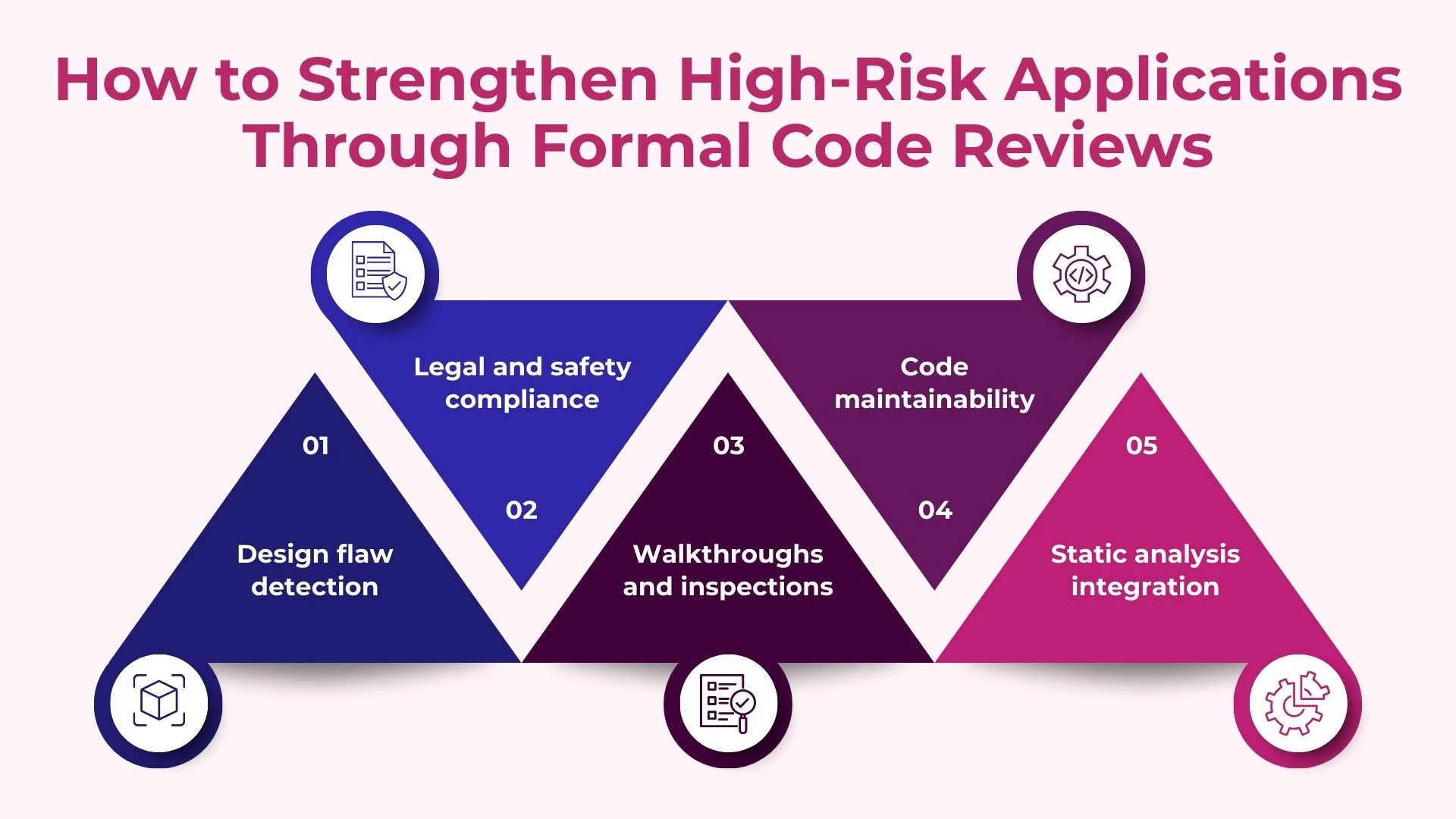
Code Review Techniques: Walkthroughs, Inspections, Peer Reviews
Code reviews are key components that ensure adherence to coding standards, helping development teams identify syntax errors and potential issues before they reach production. It involves several structured methods:
Code Walkthroughs: Developers lead a group in an explanation of code segments while soliciting comments and ideas.
Peer Reviews: Members of the team work together to assess code for logical mistakes, coding conventions, and possible flaws.
Formal Inspections: A thorough, checklist-based examination with predetermined entry/exit criteria and roles (author, moderator, and reviewer).
Benefits of Code Review
- Better Software Quality: Removes errors and maintains uniformity.
- Knowledge sharing: Through cooperative inspection, it improves team learning.
- Simplified Maintenance: Long-term management of code that is cleaner and more documented is simpler.
- Risk reduction: Assists in keeping coding errors and performance problems from making it to production.
- Assurance of Compliance: Facilitates auditability and conforms to industry norms.
By aligning with clear code review goals and utilizing static analysis tools in software testing, teams can consistently deliver cleaner, compliant, and more maintainable code—strengthening both quality and long-term project success.
Integrating Static Testing into Software Development Life Cycle Phases
Incorporating static testing early in the Software Development Life Cycle (SDLC) is essential for building reliable, high-quality software. Static analysis testing ensures that development is built on a strong foundation by enabling teams to find errors in requirements, design documents before actual coding starts. In addition to reducing rework, this proactive strategy speeds up development and cuts expenses.
Because it incorporates quality checks from the outset, early-phase static testing is ideal for agile and secure software development life cycle models. By including crucial feedback loops into the planning process, it promotes cooperation among developers, testers, and business analysts.
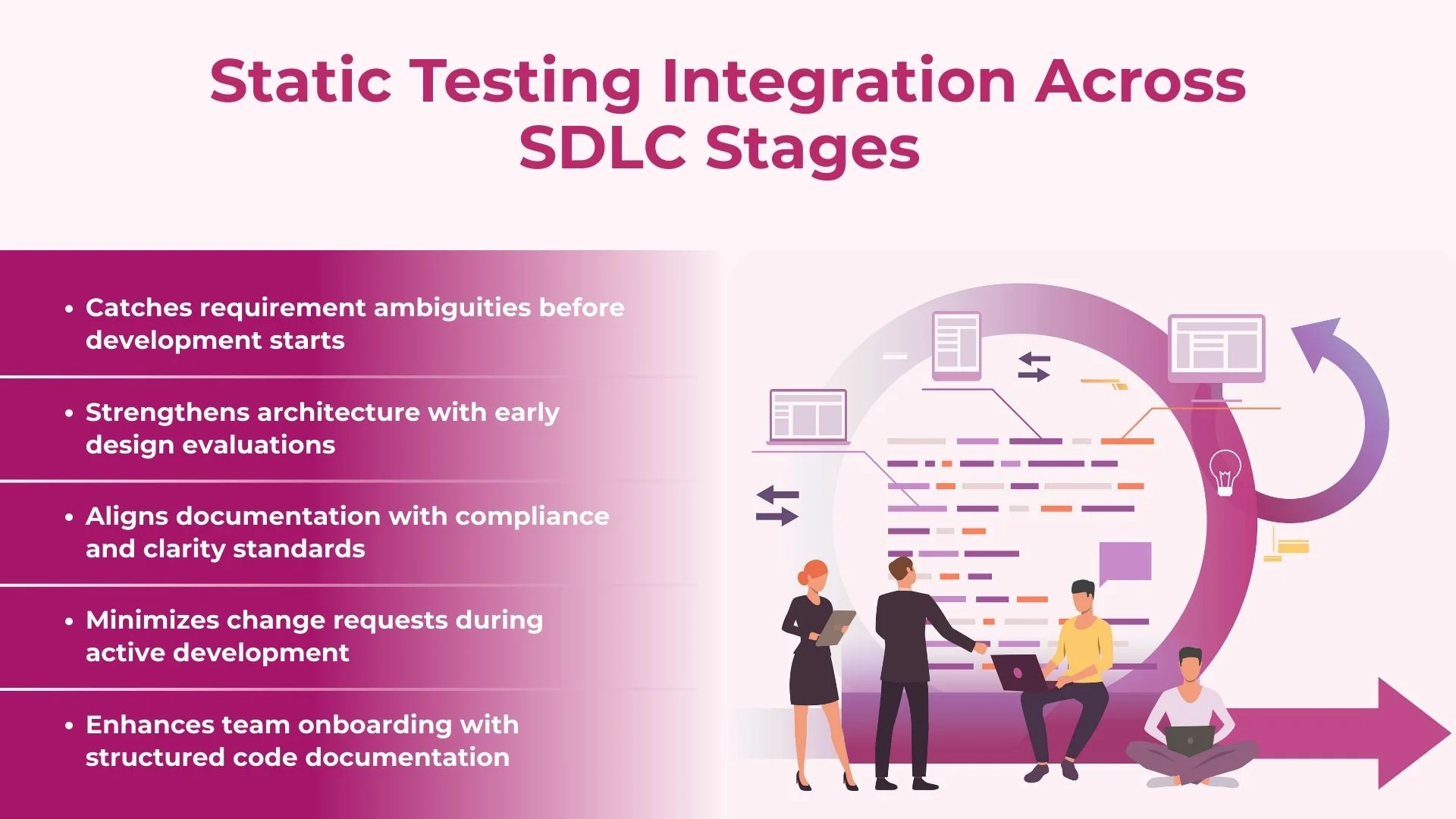
Requirement and Design Review for Early Defect Detection
Early analysis of business requirements and functional requirements helps prevent misinterpretation, leading to fewer reworks in later stages. Using review analysis guarantees that:
- Before development begins, ambiguities in the requirements are found and clarified.
- By identifying incomplete use cases, functionality gaps are minimized.
- Early resolution of architectural flaws enhances software performance and structure.
During the development stage, these early assessments aid in lowering the number of modification requests.
Documentation Reviews in Early SDLC Phases
Good code documentation facilitates team onboarding and long-term software maintenance. Static code analysis guarantee:
- Precision: Every logic and function is explained precisely.
- Comprehensibility: The documentation is simple to comprehend.
- Standard Compliance: Complies with external or internal requirements for documents.
As software evolves, consistently enhancing documentation quality becomes achievable through the use of code documentation tools and modern practices like documentation as code, ensuring clarity, maintainability, and alignment with development standards.
Types of Static Testing
In software development, static testing is primarily categorized into manual and automated methods.Though their methods, tools, and degrees of automation vary, both types aim to find flaws without running the application code.
Manual Static Testing
In order to analyze software artifacts like code, design documentation, and requirements, manual static testing depends on human participation. Early in the software development life cycle, this method works well for identifying logical errors, unclear requirements, and design defects.
- Code Walkthroughs: In order to get informal comments and suggestions, developers show their code to their colleagues.
- Design Documents Inspections: Methodical evaluations to confirm architectural choices.
- Requirement Reviews: Business and QA teams evaluate the accuracy and completeness of the documentation.
- Manual reviews improve teamwork and promote code peer review. They take a lot of time, but they provide detailed information that automated programs might overlook.
Automated Static Testing
Automated static testing process involves examining source code for grammatical mistakes, code smells, security flaws, and standard non-compliance using automated software testing techniques which saves time compared to manual process
- Integrates with CI/CD pipelines
- Provides thorough reports on application code review
- Allows for extensive projects with little manual efforts
QA teams may provide comprehensive, effective, and scalable static code testing coverage across projects by integrating automated and manual methods.
Best Static Testing Tools Every QA Engineer Should Know
Selecting the appropriate static testing tool aids in maintaining code quality and automating error identification. Among the examples are:
- SonarQube: Finds security vulnerabilities, errors, and code smells
- Checkstyle: Helps maintain coding standards in Java applications
- PMD: Identifies duplicate code and improper behavior
- Lint: Draws attention to grammatical and stylistic mistakes in code
Workflows involving continuous integration depend on these automated testing tools.
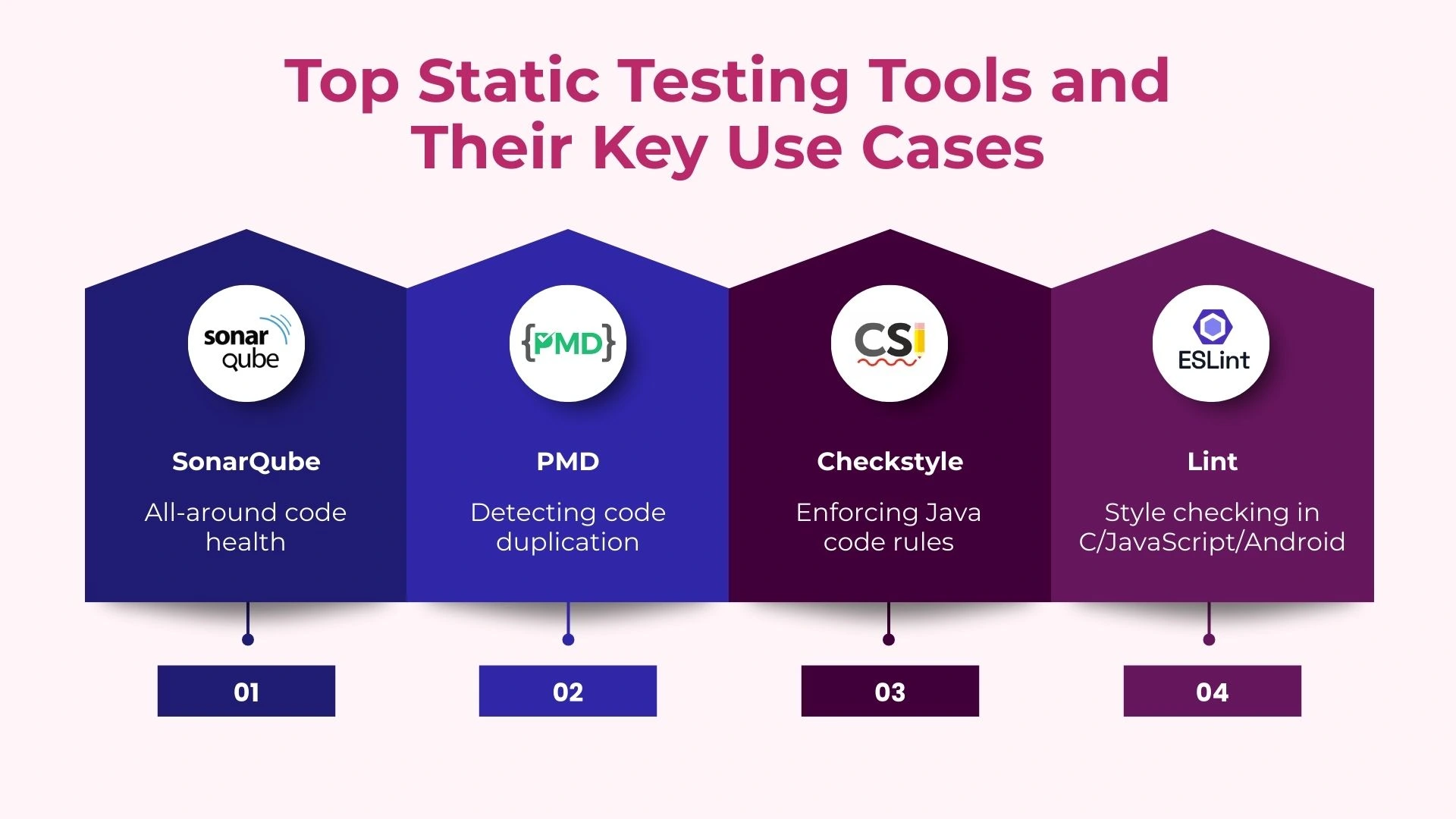
Key Benefits of Static Testing for Quality Assurance Teams
There are many benefits to software development when static testing is applied early, including improved code quality, reduced rework, and streamlined collaboration.It minimizes testing team efforts in the later stages, reduces exposure to security vulnerabilities, and boosts overall development productivity by identifying flaws early.
The main benefits are listed below:
1. Early bug detection
- It helps fix problems during the design or documentation stages by identifying defects before the code is run.
- Stops bugs from being escalated to later stages of the SDLC
- Reduces expensive rework and production errors
2. Better Code Quality:
- Static testing identifies logical mistakes, grammar problems, and coding standard violations.
- Promotes code maintainability and uniformity
- Assists the team in reaching code review objectives.
3. Improved Documentation Validation:
- Guarantees that requirements, test plans, and user manuals are clear and comprehensive.
- Maintainability is supported by appropriate source code documentation.
- Encourages cooperation between different teams
Cost-Efficiency:
- It is less expensive to fix flaws early than in the later stages of the development cycle
- Cuts down on rework, delays, and overspending
- Encourages resource optimization throughout the undertaking
Enhances Team Collaboration:
- Promotes peer-to-peer communication by means of organized walkthroughs and evaluations.
- Promotes shared responsibility for identifying and reducing issues in code
- Improves developer-tester communication
Mitigation of Security Risk:
- Early vulnerability detection in the secure software development life cycle is aided by static analysis.
- Enhances adherence to security requirements by identifying insecure code patterns.
Challenges QA Teams Face in Adopting Static Testing
Static testing has many obvious advantages, but QA teams may run across a number of real-world issues when putting it into practice. These challenges have the potential to postpone adoption and lower the static code testing strategy's overall efficacy. Understanding these problems is essential to creating a practical and expandable QA procedure.
The following are a few of the most typical difficulties encountered:
- Opposition to Change: Because they perceive peer reviews and code inspections as disruptions to their productivity, developers may be reluctant to implement them.
- Tool Complexity: Initial adoption of many static testing technologies is challenging due to their high learning curve and need for customization.
- Time Restrictions: If not adequately planned, static testing tasks like code documentation reviews and inspections can take a lot of time.
- Lack of Awareness: Teams may underuse static approaches as a result of their incomplete understanding of the long-term advantages of software testing.
- Integration Gaps: Automation may be slowed down if static testing is difficult to include into CI/CD pipelines or agile procedures.
- Measuring the ROI of reduced testing efforts and integrating static testing seamlessly into the verification process.
Strong leadership, appropriate training, and coordinating the static software testing procedure with the overarching objectives of the software development life cycle are necessary to overcome these obstacles.
Conclusion: Building a Robust QA Strategy with Static Testing
Static testing is a fundamental aspect of quality assurance and serves as a strong supplement to traditional testing methods. Its contribution to software quality is indisputable, ranging from product review analysis to early fault discovery in the design phase and initial stages of development. By catching defects early, static testing significantly reduces testing efforts and supports early identification of security issues and code vulnerabilities.
QA teams may guarantee reliable, safe, and scalable software products by incorporating static testing early in the agile software development life cycle, ensuring adherence to coding standards, utilizing the appropriate automated software testing tools, and encouraging a robust code review culture.
The benefits of software testing extend beyond just defect detection—it enhances product reliability, increases user satisfaction, and ensures compliance with industry standards. To effectively utilize the full potential of static testing, teams should start small, assess the impact, and continuously adapt their approach for long-term success.
Modern QA strategies also benefit from exploring AI-driven test automation services and platforms such as Frugal Testing, which offer specialized support including functional testing services, load testing service, and SaaS application testing company solutions to scale quality efforts efficiently and cost-effectively
H2 - People Also Ask
1. Is there a role for AI or machine learning in modern static testing tools?
Indeed, by identifying patterns, lowering false positives, and prioritizing important concerns, AI/ML improves static testing tools and increases the precision and effectiveness of static analysis in contemporary software development processes.
2. Can static testing be used without executing the application code?
Of course. Static testing is perfect for early-stage fault detection in the software development life cycle since it examines programming code, documents, and architecture without running them.
3. How does static testing support regulatory compliance in industries like finance or healthcare?
Static testing identifies code and documentation issues early, ensuring adherence to industry regulations like HIPAA or PCI-DSS and helping teams pass audits efficiently.
4. Is static testing useful for open-source project contributions?
Yes, static testing improves code consistency, detects issues early, and ensures alignment with open-source contribution standards, leading to cleaner, more maintainable commits.
5. How frequently should static testing be performed in a project?
To identify problems early and preserve continuous quality across the software development life cycle, it should be carried out on a frequent basis—during each sprint, code commit, or design update.





%201.webp)

